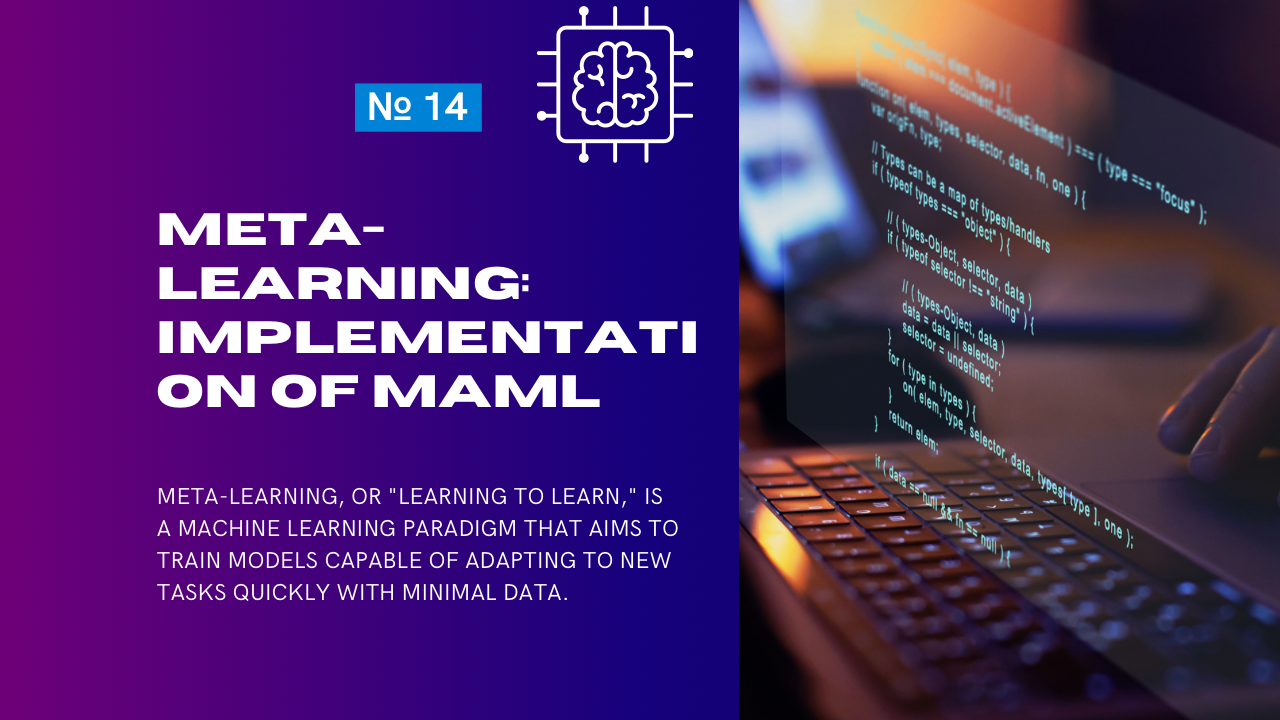Meta-Learning, or “learning to learn,” is a machine learning paradigm that aims to train models capable of adapting to new tasks quickly with minimal data. Model-Agnostic Meta-Learning (MAML) is a popular algorithm in this domain. It focuses on learning a good initialization for model parameters so that the model can adapt to new tasks using just a few gradient steps.
What is MAML?
MAML is a meta-learning algorithm designed to optimize model parameters for fast adaptation to new tasks. It achieves this by finding a shared initialization across tasks such that the model performs well after fine-tuning on a small amount of task-specific data.
Key Idea: Learn a universal set of parameters ((\theta)) that can be fine-tuned for a new task with just a few gradient descent steps.
MAML Algorithm
- Initialize Parameters ((\theta)):
- Start with a shared initialization across all tasks.
- Task Sampling:
- Sample a batch of tasks ((T_i)) from a task distribution.
- Inner Loop (Task-Specific Update):
- For each task (T_i):
- Use the task-specific dataset ((D_{train})) to compute gradients and update parameters:
[
\theta_i’ = \theta – \alpha \nabla_\theta \mathcal{L}{T_i}(f\theta)
]
Where (\alpha) is the inner learning rate.
- Use the task-specific dataset ((D_{train})) to compute gradients and update parameters:
- Outer Loop (Meta-Update):
- Evaluate the updated parameters (\theta_i’) on a validation dataset ((D_{val})):
[
\mathcal{L}{meta} = \sum{i} \mathcal{L}{T_i}(f{\theta_i’})
] - Update the shared parameters (\theta) using the meta-loss:
[
\theta = \theta – \beta \nabla_\theta \mathcal{L}_{meta}
]
Where (\beta) is the outer learning rate.
- Repeat:
- Iterate through multiple tasks until convergence.
Implementation of MAML in Python (Using PyTorch)
Here’s a simplified implementation of MAML for a binary classification problem:
import torch
import torch.nn as nn
import torch.optim as optim
# Define a simple neural network
class SimpleNet(nn.Module):
def __init__(self, input_size, hidden_size, output_size):
super(SimpleNet, self).__init__()
self.fc1 = nn.Linear(input_size, hidden_size)
self.fc2 = nn.Linear(hidden_size, output_size)
def forward(self, x):
x = torch.relu(self.fc1(x))
x = torch.sigmoid(self.fc2(x))
return x
# Define the MAML algorithm
class MAML:
def __init__(self, model, inner_lr=0.01, outer_lr=0.001, inner_steps=1):
self.model = model
self.inner_lr = inner_lr
self.outer_lr = outer_lr
self.inner_steps = inner_steps
self.outer_optimizer = optim.Adam(self.model.parameters(), lr=self.outer_lr)
def train_on_task(self, task_data):
# Split task data into training and validation sets
train_data, val_data = task_data
# Clone model for inner loop
task_model = SimpleNet(*[param.shape for param in self.model.parameters()])
task_model.load_state_dict(self.model.state_dict())
# Inner loop: task-specific fine-tuning
task_optimizer = optim.SGD(task_model.parameters(), lr=self.inner_lr)
for _ in range(self.inner_steps):
loss = self.compute_loss(task_model, train_data)
task_optimizer.zero_grad()
loss.backward()
task_optimizer.step()
# Compute validation loss
val_loss = self.compute_loss(task_model, val_data)
return val_loss
def compute_loss(self, model, data):
inputs, targets = data
predictions = model(inputs)
loss = nn.BCELoss()(predictions, targets)
return loss
def meta_update(self, meta_loss):
# Outer loop: meta-update of model parameters
self.outer_optimizer.zero_grad()
meta_loss.backward()
self.outer_optimizer.step()
def train(self, tasks):
for task_data in tasks:
meta_loss = self.train_on_task(task_data)
self.meta_update(meta_loss)
# Example usage
input_size = 10
hidden_size = 32
output_size = 1
model = SimpleNet(input_size, hidden_size, output_size)
maml = MAML(model)
# Generate dummy tasks for training
tasks = [
(
(torch.randn(32, input_size), torch.randint(0, 2, (32, 1)).float()), # Train data
(torch.randn(32, input_size), torch.randint(0, 2, (32, 1)).float()) # Validation data
)
for _ in range(10)
]
# Train MAML
maml.train(tasks)Key Components in Code
- Model Definition:
- The
SimpleNetrepresents the shared model with trainable parameters.
- Inner Loop:
- Fine-tunes the model on task-specific data using a few gradient steps.
- Outer Loop:
- Optimizes the shared initialization based on the meta-loss across all tasks.
- Task Sampling:
- Tasks are simulated here with dummy data but can be replaced with real datasets.
Advantages of MAML
- Task Agnostic:
- Can be applied to various types of tasks (classification, regression, etc.).
- Quick Adaptation:
- Learns an initialization that allows rapid adaptation to new tasks with few updates.
- Simplicity:
- Straightforward framework compatible with existing gradient-based optimizers.
Challenges of MAML
- Computational Cost:
- Requires higher computational resources due to the need to compute second-order gradients.
- Task Design:
- The performance heavily depends on the quality and diversity of sampled tasks.
- Scalability:
- Scaling MAML to very large models or datasets can be challenging.
Applications of MAML
- Few-Shot Learning:
- Classification tasks with limited labeled data.
- Reinforcement Learning:
- Quick adaptation to new environments or games.
- Robotics:
- Transfer learning for tasks like grasping and navigation.
- Healthcare:
- Personalized models for predicting patient-specific outcomes.
Future Directions
- Improved Optimization:
- Using first-order approximations (e.g., FOMAML) to reduce computational cost.
- Task Diversity:
- Incorporating more diverse task distributions for better generalization.
- Scalable Meta-Learning:
- Developing methods to apply MAML to large-scale datasets and deeper models.
